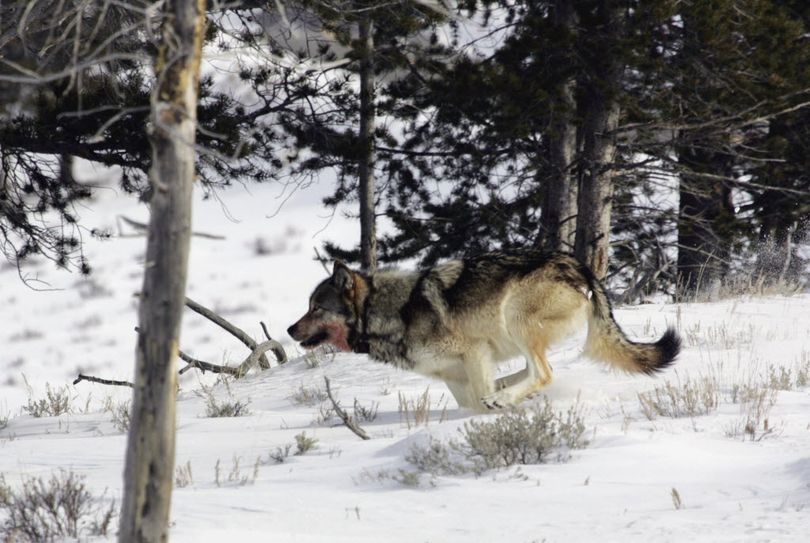Rockies wolf packs holding strong despite hunting, trapping


UPDATED: 5:20 p.m.
PREDATORS -- Gray wolves are maintaining a strong presence in Idaho despite stepped up hunting and trapping seasons plus other measures to control their numbers, according to the 2013 Idaho wolf status report released today by the state Fish and Game Department.
In addition, Montana reported its 2013 population of at least 627 wolves remained statistically unchanged from the 625 counted in 2012.
Washington as well as Oregon already have reported expansion of their wolf populations.
- Number of wolves: At least 659.
- Documented packs: At least 107, down from 117 at the end of 2012 but still the second highest number since reintroduction.
- New packs: At least seven.
- Border packs: At least 28 documented border packs overlapping with Montana, Wyoming and Washington.
- Reproducing packs: At least 49. Of those, 20 qualified as breeding pairs at the end of the year.
- Pack size: 5.4 (mean), down from 8.1 average during the three years prior to the 2009 opening of hunting seasons.
- Wolves killed: 356 by hunters and trappers and 94 by control efforts in response to wolf-livestock depredation. At least 16 wolves died from other human-related causes and 7 were found dead from unknown reasons.
- Confirmed wolf depredations: 39 cattle, 404 sheep, four dogs and one horse. Another seven cattle, nine sheep, and one dog were considered probable wolf kills.
Idaho posted its report on the deadline required of Northern Rockies states involved in the federal endangered species recovery programs.
- See wolf recovery status reports from all the affected states on U.S. Fish and Wildlife Service's Northern Rocky Mountains page.
Read on for an Associated Press story, April 4, 2014, on the regional wolf status reports with reaction from various groups and experts.
Rockies gray wolf numbers steady despite hunting
By MATTHEW BROWN/Associated Press
BILLINGS, Mont. — Gray wolves in the U.S. Northern Rockies are showing resilience as states adopt increasingly aggressive tactics to drive down their numbers through hunting, trapping and government-sponsored pack removals.
A minimum of 1,691 wolves roamed the six-state region at the end of 2013, according to figures released Friday by state and federal agencies.
That’s little changed from the prior year, despite continued political pressure from hunters and ranchers who want the population significantly reduced.
Idaho in recent months put government wildlife agents in helicopters to shoot entire packs that were preying on big game herds. Montana officials last year lifted wolf hunting and trapping quotas, increased the bag limit to five wolves per hunter and lowered the fees for out-of-state licenses.
Wildlife advocates have warned the population could crash, but that hasn’t happened: Wolf numbers are down just 6 percent since the animals lost federal protections in 2011.
“Wolves are very tenacious, they’re very prolific,” said Mike Jimenez, federal wolf recovery coordinator for the Rockies and a biologist with the U.S. Fish and Wildlife Service. “The population is very secure, but it doesn’t remove the controversy.”
Jimenez says he expects the population to gradually decline over time in the face of the states’ efforts but remain healthy overall. The only state to see a significant drop last year was Idaho, down 63 wolves to at least 659.
On the livestock side, wolves in the Northern Rockies killed at least 143 cattle and 476 sheep in 2013. That’s 51 fewer head of cattle and six fewer sheep than the prior year.
Idaho Cattle Association vice president Wyatt Prescott said the only way to keep those numbers from going up is to keep wolves in check.
“We’re not trying to annihilate wolves, but we would continue to advocate for a sheer reduction,” in their numbers, Prescott said.
A representative of a wolf advocacy group, Kurt Holtzen with the National Wolfwatcher Coalition, said he was hopeful state officials will put more resources into non-lethal wolf management. That includes placing flagging on livestock fences, using range riders to patrol grazing areas and other measures to keep wolves away without shooting them.
Government-sponsored campaigns exterminated gray wolves across most of the Lower 48 states early last century.
They’ve come back strong since being re-introduced almost two decades ago, and now occupy large parts of Montana, Idaho, Wyoming, Washington and Oregon. Part of a sixth state, Utah, falls within the Northern Rockies region but has no wolves.
The Great Lakes are home to a second major population of roughly 4,000 wolves. The southwest has a struggling group fewer than 100 wolves.
Amid a pending proposal to lift protections across much of the remaining Lower 48 states, the success of restoration efforts to date hasn’t quieted the intense debate over whether there are too many or too few wolves.
Montana Fish, Wildlife and Parks spokesman Ron Aasheim said officials were surprised the state’s 2013 population of at least 627 wolves remained statistically unchanged from the 625 counted in 2012.
A new rule adopted last month makes it easier for Montana livestock owners to shoot wolves without a permit. Aasheim said that’s expected to have limited impact because most wolves involved in livestock attacks are removed by wildlife agents.
